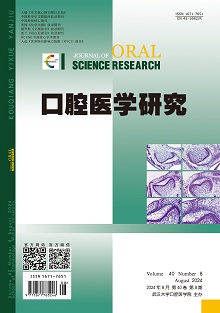|
|
Shear Bond Strength of Personalized Machined Brackets
YANG Ruiting, ZHANG Jie, XU Yafen, JIANG Yingqi, DAI Xiwei, ZHOU Yin, ZHANG Qi
2024, 40(8):
735-740.
DOI: 10.13701/j.cnki.kqyxyj.2024.08.013
Objective: To compare the bonding strength of four types of metal bottom plate brackets. Methods: Forty-eight extracted premolars were randomly assigned to eight main groups, with six teeth in each group. Personalized machined bottom bracket was adopted in group A and B, new net bottom bracket was adopted in group C and D, two-way barb bottom bracket was adopted in group E and F, and traditional net bottom bracket was adopted in group G and H. Among them, chemically cured resin adhesive was adopted for bonding brackets in group A, C, E, and G, light-cured resin adhesive was adopted for bonding brackets in group B, D, F, and H. Before the bonding experiment, the bottom plate was observed with the scanning electron microscope. The shear strength of each bracket was measured with a universal material testing machine, and the adhesive residue on each bracket was counted. Results: When using chemically cured resin adhesive, the bonding strength of the brackets on the two-way barb bottom bracket was lower than that of other three kinds of brackets (P<0.05). When using light-cured resin adhesive, compared with other three kinds of brackets, the two-way barb bottom bracket had the lowest bonding strength, the new net bottom bracket had the lowest bonding strength, the traditional net bottom bracket and the personalized machined bottom bracket had the highest bonding strength, and the difference was statistically significant (P<0.05). There was no significant difference in bonding strength between the traditional net bottom bracket and the personalized machined base bracket (P>0.05). There were significant differences in ARI scores among all groups (P<0.05). ARI score in group H was the smallest, and the difference between group H, group A, and group E was statistically significant (P<0.05). Conclusion: The use of chemically cured resin adhesive or light-cured resin adhesive has no obvious effect on personalized machined bottom brackets bonding strength, and the bonding strength can meet the requirements of orthodontic clinical bonding. The fracture site of group H was relatively closer to the enamel, and the risk of enamel damage in the other groups was less during the process of debonding.
References |
Related Articles |
Metrics
|

